Rewrite #3: Matt Smith's Chin, Accosting Ernest Shackleton, and Other Minutiae
In which we look at similes, Scrivener, and structure...join in!

Hello again, dear readers,
Thanks for joining me as I pour my heart out on the (digital) page: rewriting is tough work. But worth it, right?! Well, let’s hope so.
I’ve been thinking about what to call the folks who read It’s Not Working (Yet). I feel like communities are always drawn together by a sweet, catchy name. Given my focus on the power of “yet,” I’m feeling a play on that word makes the most sense.
How about “yetis”?
Is that offensive? (If you have to ask, then it’s probably offensive, right? I don’t know. I googled it. Seems okay. Lots of companies and products with “yeti” in it. That's a good sign, right?)
What do you think? “Yetis”? Get in touch. Give me something better. Please!

Similes are like…hard.
In the last week, I’ve put exactly 750 words into the draft. An interesting figure. Many times, you'll hear writers talk about how subsequent drafts will get shorter and shorter as they cut the dead weight. I'm sure that needs to happen here, but what do 750 words really mean? In effect, I’ve added two or three pages. This does not surprise me. I’ve identified two items with the draft that I’d like to play with more (or “fix”):
- I want to spend a little more time in the character’s heads. In the first draft, things sometimes feel a bit too much like reportage, like I’m just observing what these characters are doing. I want to get a bit more into their thought processes. I did this pretty well for Lorraine. For Adam, though, no. He needs an inner life. I wonder if this is because Adam is a bit easier for me to understand: white, college-educated, heterosexual male. Maybe I just assumed everyone understood what he was thinking and feeling. His inner life, however, exists, is unique, and needs to grow more complex as I rewrite.
- The voice I’m going for is a bit loquacious and bombastic. This is especially true of the Gilly family. They have the gift of gab and a way with words. Words are kind of the currency in their household, so they need to blabber a bit. But, of course, this has to be fun and interesting. There's a balance here. I don't' pretend that I'm striking that balance...yet... :)
At any rate, I’m not surprised that the manuscript has grown a bit. This will likely be true overall. I wouldn’t be surprised to see it go from ~61,000 words to closer to 75,000 in this second draft. Then, for draft three, I will likely pair it down a few thousand. But, of course, we’ll see.
As I was writing on Monday, I found myself a little caught up with the idea of simile. At one point, Adam touches his mother’s foot and her toes are absolutely frigid. Here’s what I wrote:
Adam sat down on the coffee table and put his hand on his mother’s foot. It was ice-cold, her toes like…
I froze. What were her toes like? What does a young man from southeast Texas have to describe as “cold” aside from ice cubes? Popsicles? Ice cream? Ice cream sandwiches? I couldn’t come up with anything.
This got me thinking about similes. What use are they? What are they for?
As an English teacher, I’m constantly trying to get my students to notice figurative language: Look at this metaphor! Check out this simile! It’s the greatest thing, kids: hyperbole! Isn’t hyperbole the absolute greatest?!?!?!
But what makes for a good simile? A good simile really needs two key characteristics.
First, the simile must be apt. It needs to really hit the nail on the head. When we read it, we want to say, “Yes…that’s perfect. I understand the comparison exactly.”
This part is easy, to be frank. “Her toes were as cold as ice.” Yup. Nailed it. I know what ice feels like, and I can imagine toes that feel that cold.
But, geez, what a shitty comparison! Who cares?!?!?! Why even take the time? What does that give the reader that’s any better than saying, “Her toes were really cold, y’all”?
Therefore…
Second, the simile should be a bit strange or surprising. The effect of the simile is to open up a new world for us, to help us see things in a brand-new way.
This is where the art of the simile really works its wonders. You have to find something incredibly familiar, yet strange and surprising.
One of my favorite similes comes from, of all places, the world of ESPN’s Sportscenter. One of the anchors, the late, great Stuart Scott, would often describe athletes performing under pressure as “cool as the other side of the pillow.”
Holy smokes! That’s apt, strange, and surprising. I know exactly that feeling of flipping the pillow on a hot Texas night. I also know what it means to be cool under pressure. Beautiful!

Beyond apt, strange, and surprising, if you can find something that thematically rhymes with what you’re writing, then you’ve really won the day.
I was watching an episode of Doctor Who with the fam when I heard a simile that hit all of these for me. In an episode called “Hide” (series 7, episode 9), the Doctor and Clara have gone to a haunted mansion in 1974. At one point in the episode, Clara has a conversation with Emma, a psychic ghost hunter, about Emma’s infatuation with her ghost-hunting partner, Alec. (The writers here really don’t give two shits about the Bechdel Test. We’ve got two women on screen together, alone, and all they want to talk about are the men in their lives. Missed opportunity!) Emma, the psychic, can’t interpret how Alec feels about her. Yes, ironic for the psychic, but the show takes pains to point that out. In reply to all of this, Clara tells Emma it's obvious how Alec feels about her: Alec’s infatuation with Emma “sticks out…like a…like a big chin.”
Glorious!
- Apt: We’ve all seen some big chins out there, and we know how they stick out. Let’s not pretend, okay?
- Strange: The phrase “sticks out like a big chin” is hardly obvious. It helps us to see things in a new way.
- Thematic Rhyme: The 11th Doctor, portrayed by Matt Smith, has a bit of a chin, y’all. Again, let's not pretend otherwise. Moreover, Clara is trying to understand her relationship with the Doctor, so her coming to this big chin idea is a nice little nod to that conundrum of hers.


The simile floored me, dumb as it may seem.
Okay, so a great simile needs to be apt, familiar-yet-strange, and it needs to play nice with the big ideas you’re working with in the rest of the piece? Yes. Good. Do that!
Except, I don’t have that here.
When we read this section, we know that Lorraine is about to die. I toyed with that a bit: “Her toes were cold, like a kidney waiting for transplant.” Uhhhh…no. Yes, it resonates with the morbidity of the scene, but how does Adam even know how cold a kidney would be? (NOTE: I don’t know how cold a kidney needs to be. What weird knowledge does Adam possess?)

So, you play with it.
- Her toes were cold like an undertaker’s marriage bed.
- Her toes were cold like Shackleton’s balls.
- Her toes were cold like…
So, we keep hammering at it, I guess.
What’s silly, I suppose, is that this is a minor thing. This guy touches his mom’s foot. Why obsess over a simile here? Well, it felt right as I was drafting it. I wrote the word “like”…I’m primed for a simile. It fits with the rhythm of what’s going on. It also rhymes with the theme. She's gonna die...let's get that body cold!
But is it best to just cut it? I don’t know. Here’s what’s now in the draft:
[Her foot] was ice-cold, her toes like TK.
I’ll keep it like that for a while and see where things go.
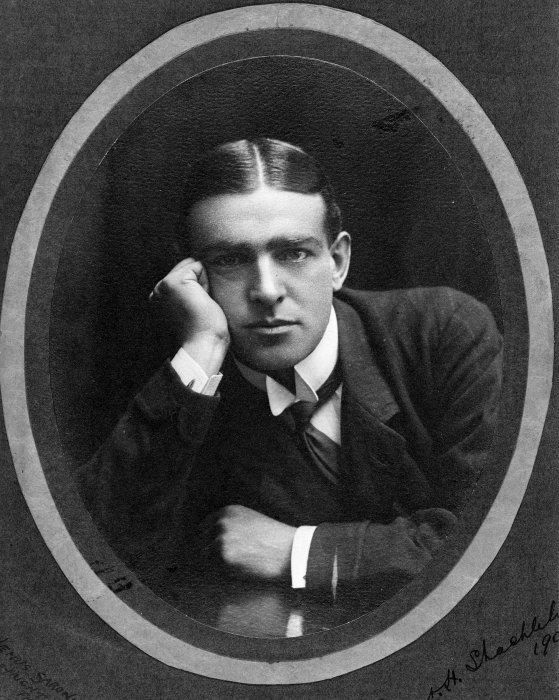
The Setup: Scrivener Basics
As I’ve mentioned, Scrivener is a very complicated application. Therefore, I want to spend some time in these opening weeks giving you an idea of how I’m using it. (I’m not, by the way, saying this is the way to use it. I’m just doing what makes sense to me.)
Today, we’re going to focus on my folder structure and how that informs my process for this rewrite.
Folder Structure
Here’s a screenshot of Scrivener as I’ve got it going now.
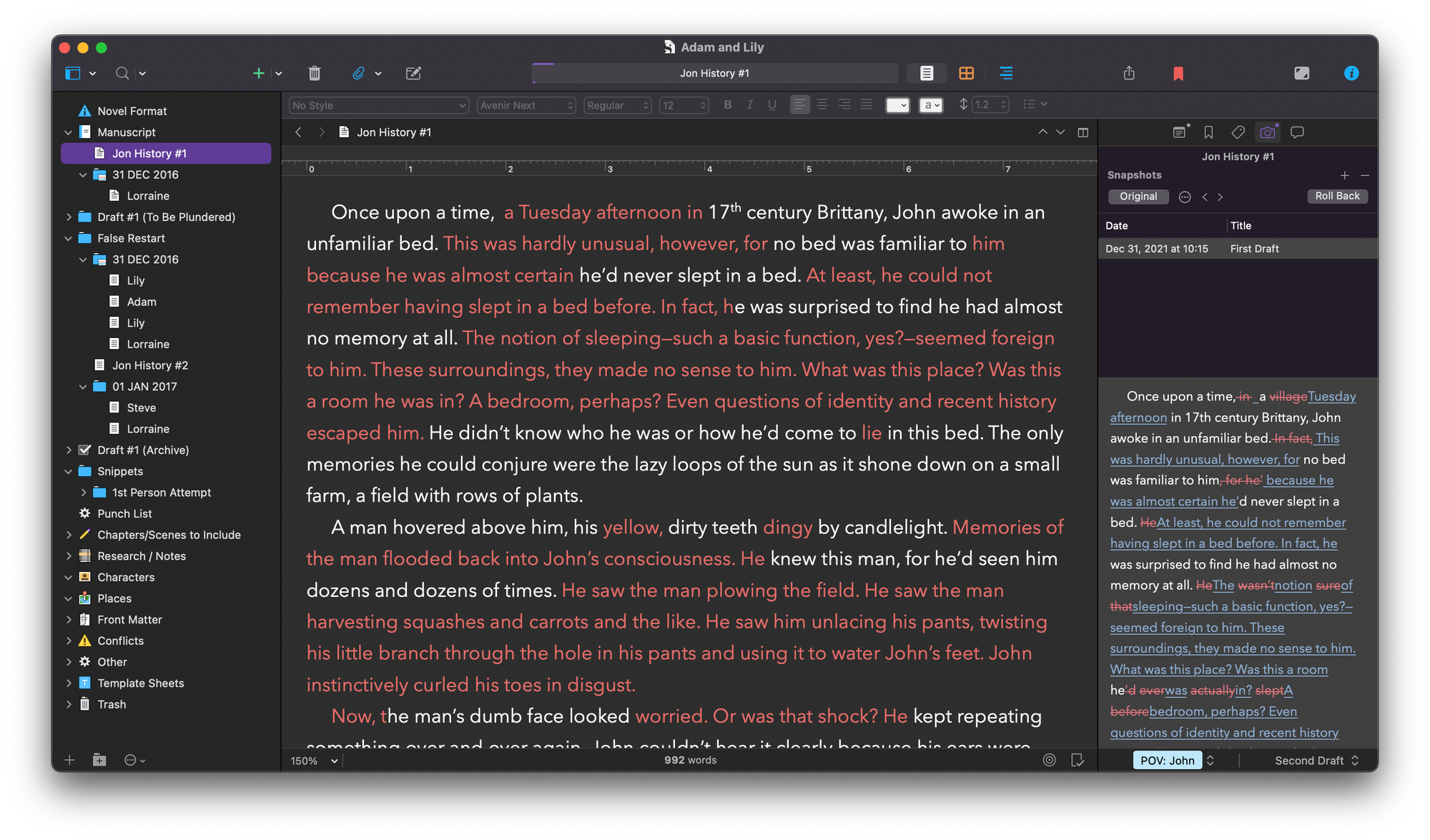
For now, I want to concentrate on the folder structure in the left sidebar. Scrivener calls this the “Binder.” Much of what I have going on in here might seem pretty straightforward: Manuscript, Research / Notes, Trash. (Holy smokes! I just opened up the trash and found a lot of shit in there. I was going to empty it, but now I think I’ll hang on to it. Mon dieu!)
Even if it is straightforward, I want to think with you about a few of the items in here:
- Why are there two different folders with “Draft #1” in them?
- What is “False Restart”?
- What are “Snippets”?
Let’s dive in!
“Draft #1 (Archive)” and “Draft #1 (To Be Plundered)”
I wrote the first draft of Lorraine in this Scrivener project and had the whole damn thing in “Manuscript.” When you put text in Manuscript, it’s usually marked for compile, meaning you can easily export it to the format you want. During the drafting process, I loved hitting that compile button and watching Scrivener put together my manuscript so that I could scroll through it.
Lots of pages. Deeply satisfying.
Now, however, it’s time to rewrite, so I pulled the draft out of the Manuscript folder and labeled it “Draft #1 (Archive).” I also gave it that checkbox icon. Some information about this draft in Scrivener:
- This draft contains 60,087 words.
- The draft is arranged into 18 chapters (including an epilogue...'cause I'm fancy like that). Each chapter is its own folder.
- Each chapter has 1 to 5 scenes in it. Each scene is its own document.
- In total, the draft includes 47 different documents.
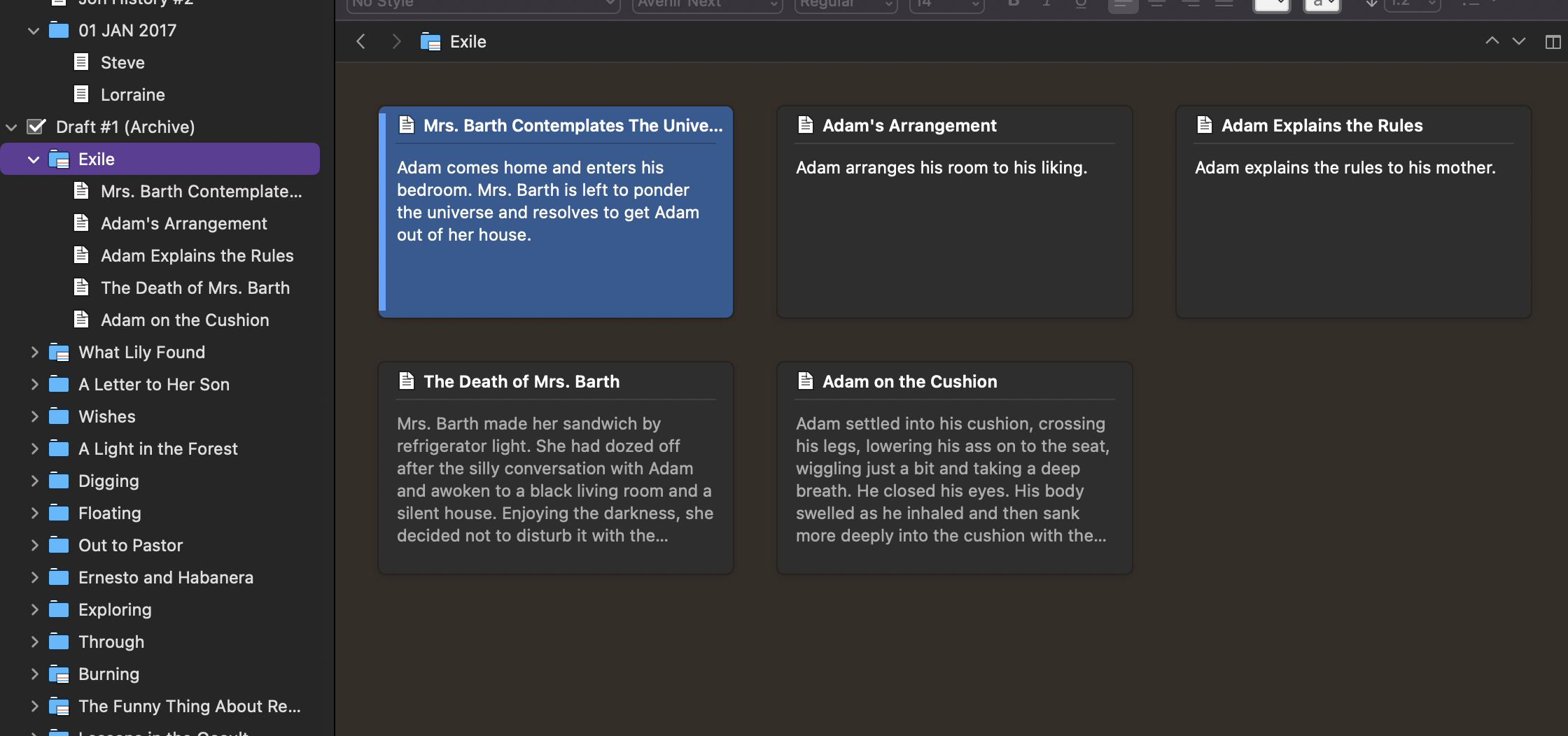
I give you these stats because putting that thing together was a lot of freaking work! I don’t want to lose it. This is why “Draft #1 (Archive)” exists. It is a copy of the draft that will never be touched and never be altered.
I could have done this in numerous ways. I could’ve taken snapshots, a cool Scrivener feature we’ll be looking at some time later. But, to be perfectly honest, I didn’t know how to use snapshots when I started this rewrite. That being said, I’m still not sure that I would’ve used a snapshot. I really wanted a whole draft for posterity. So, there it is.
“Draft #1 (To Be Plundered)” is precisely what it sounds like. It’s a copy of the manuscript that I can play with. As of this writing, the structure of it looks the same. This is because I’ve only edited one scene (see all the red in the screenshot below?), but I decided to rewrite the scene from scratch because I wanted to rethink the narrator’s voice.
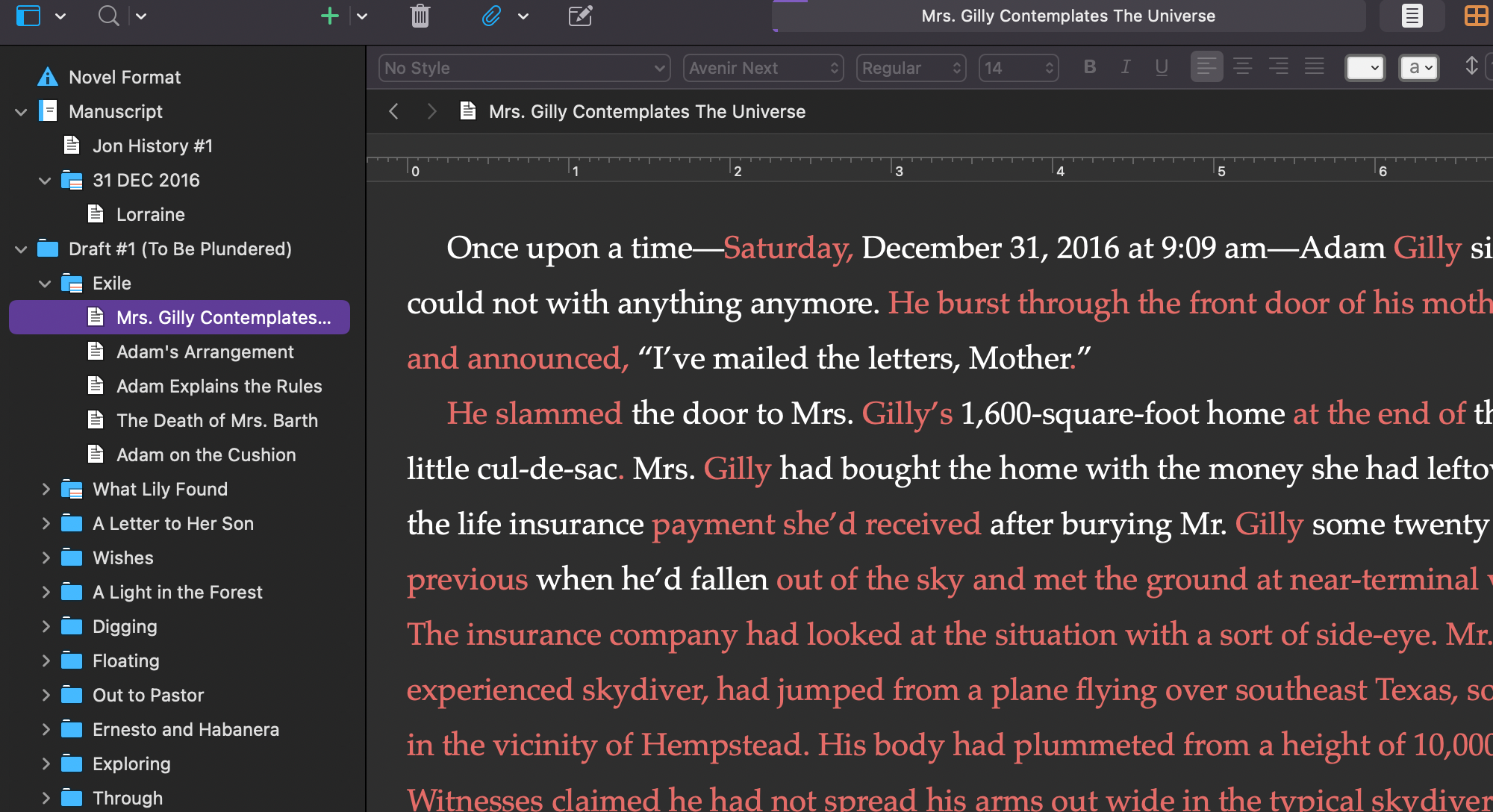
As I go, I will likely copy and paste scenes from this draft into the manuscript, revise them, mess with them, rearrange them, etc. That being said, I am finding that much of what I'm doing is really re-drafting from the ground up. Therefore, much of what you see in “Draft #1 (To Be Plundered)" will likely stay the same. Instead, I'll have new documents in the manuscript with those scenes completely rewritten.
“False Restart”
“False Restart” is a folder where I started a new draft some time ago: March 2020, I think. Geez. What a harrowing, ominous time to start a new project!
This folder has some crazy stuff in it because I was trying all kinds of things. Skimming through here, I see that I attempted to rewrite the novel in the first person. I’ve pulled that attempt out into its own place. It’s a wild rewrite. I don’t like it, but maybe there’s something in there I can use.
I also see that I started playing a lot with structure and voice. I like aspects of this, but the story starts to veer radically in directions I don’t understand. At one point, Lily comes home to find her father sitting at the table over a bowl of what appears to be breakfast cereal. It’s not cereal at all, however. He has torn up all the family photos that contain his ex-wife and has put them into a bowl with some milk and begun eating them.
Hm.
I suppose one day — most likely in the wake of my Pulitzer Prize speech — someone will dig this up and talk about how Stephen Hebert wrote a scene about a man who is eating torn-up photographs. This will be used to discredit me. But, vulnerability and honesty are a key part of this inwy endeavor, soooo…I spare you nothing, dear reader. Enjoy that crazy image. Make of it what you will.
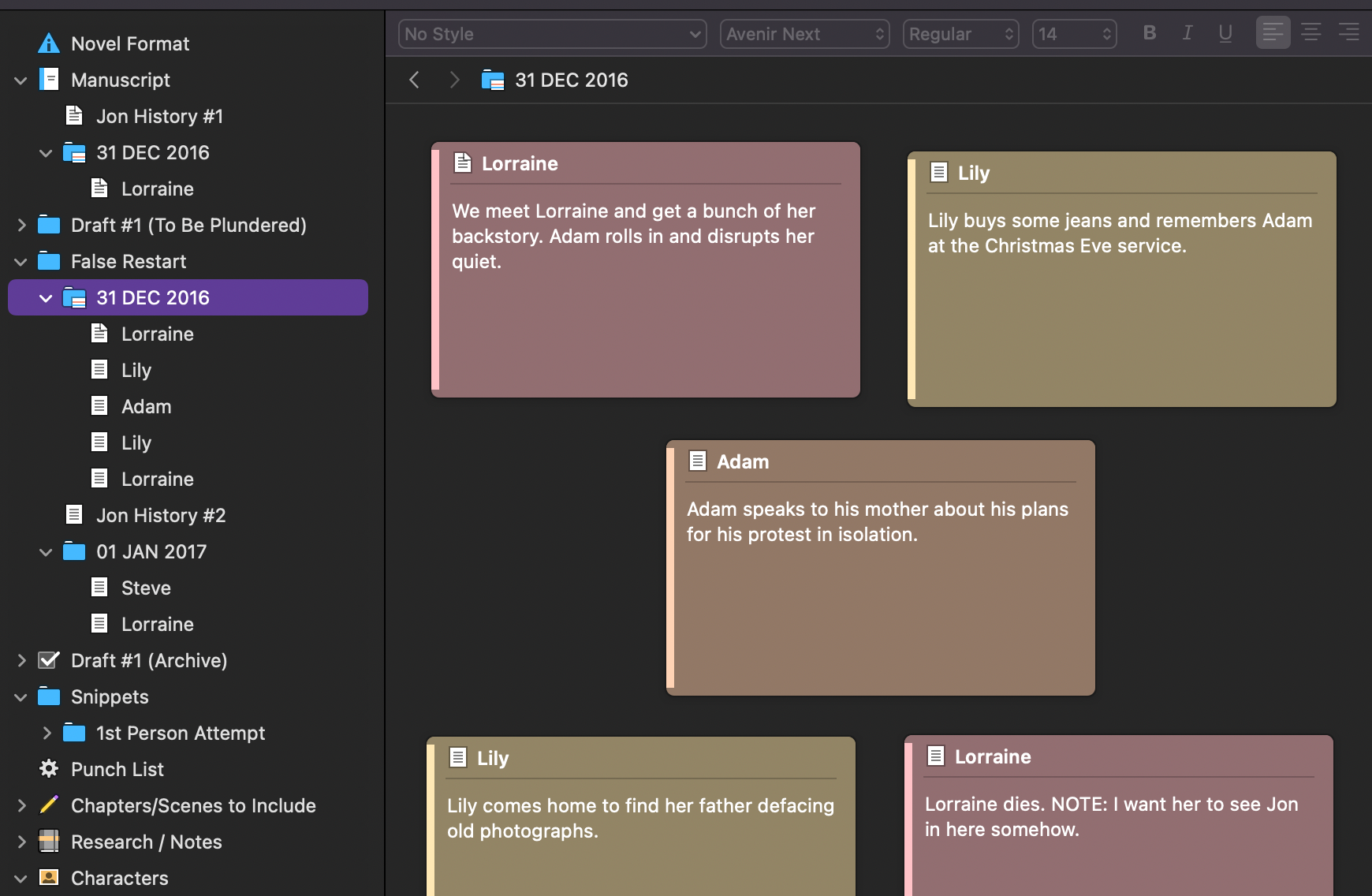
In sum, “False Restart” contains a lot of good and a lot of bad. I’m taking snapshots of it and then editing it directly. The two scenes that appear in Manuscript right now are both from “False Restart,” but they’ve already been drastically reworked.
Why did I choose those scenes?
The first scene did not exist in the original manuscript. It gives the backstory for a character we will meet later on. I like it and like it as a short, punchy opening that leaves the reader with a kind of the-hell-is-this? feeling.
The second scene is a reworking of the opening. The voice in here is way better and Lorraine is more fully fleshed out. She’s become almost cartoonish. She feels like she’s straight out of Julia Elliott’s The New and Improved Romie Futch.
NOTE: If you haven’t read The New and Improved Romie Futch, you really need to go ahead and do that. You want to read a novel about a down-on-his-luck taxidermist who, through some insane biomedical experiment, becomes...like...the smartest man alive. At one point, he attends a party while wearing a taxidermied boar's head like a mask/helmet. Listen...just go ahead and read it. I’ll wait…
Done?
Good. Let’s get back to it.
I really liked the voice and some of the backstory. It sets the tone I want to go for: a sardonic fairy tale set in southeast Texas in the early 21st century. Cool. So, I copied it into Manuscript and then started using Scrivener’s revision tools to get after it.
Snippets
For every major writing project I do, I create a document or a folder called “Snippets.” This is a really disorganized inbox. Any time I have an idea, I start to write it out and I throw it in snippets. I do mean any time. Sometimes, I dictate these things into my phone while I’m driving. Sometimes, I stop in the middle of making dinner and throw one down there. Sometimes, I write out a snippet in between shots on the golf course. I’ve even written snippets during bubble baths.
Yes. Bubble baths. Don’t judge!
In the project for my next novel, I have over 20,000 words worth of snippets: little bits of dialogue and description that I can come back to any time.
I’ve done the same thing here, though most of those snippets were plundered during the actual drafting process. If, however, as I’m writing, I feel inspired by something, if that little voice creeps into my head, I collect it and put it into snippets.
(NOTE: This is part of my writing philosophy — always be capturing. This will appear as “Workables #5” next week, so stay tuned.)
Snippets, then, is a catch-all, any piece of writing that could be used but doesn’t currently have a place…well, throw it in snippets.
What’s Next?
We’ve talked about snippets, Scrivener folder structures (just scratching the surface there), and similes. What’s next? Well, I’m going to keep on hacking away at this manuscript for another six or seven days, then I’m going to get back to you. Here’s what I think you’ll be able to look forward to in the next edition of (Re:)write:
- An update that, I think, will include rather harrowing tales of: (1) How I’m managing to rewrite this thing as I return to the day job. How do I fit writing in? (2) I’ve hit a scene that needs a lot of work. Specifically, it’s the voice. What’s going on? How am I managing? Open next week’s missive to find out!
- More stuff about Scrivener: Snapshots and Revision Mode.
- Maybe: Thoughts on taking notes during the writing process. Though, I might save that for a future issue. We’ll see if it fits in.
I thank you for coming on this journey with me! Until next time…
Fun Fact: There are twenty-four exclamation points in this edition! Strike that…twenty-five…
If you're reading this and haven't subscribed yet, please consider doing so! You'll get inwy "(Re:)write" (and more) delivered right to your inbox. If you are a subscriber and you find inwy is bringing value to your practice, consider becoming a donor. What do you have to lose? Well...a few bucks, I suppose. :)
If you have thoughts about this edition, please feel free to get in touch with me:
- You can find me on Twitter: @sbhebert.
- If you're a subscriber, you can click "Contact Support" in the account portal and send me an email.
I'd love to hear from you!